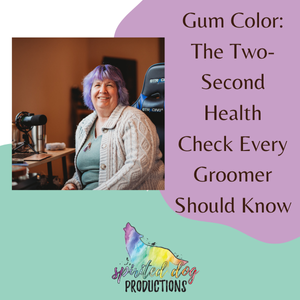Gum Color: The Two-Second Health Check Every Groomer Should Know

Gum Color: The Two-Second Health Check Every Groomer Should Know What if I told you could tell if a pet is healthy enough to groom in about two seconds? It’s true! It’s all in the gum color. Let’s start with how to check. A word of caution, especially if this is a new client. A cone can protect you while still allowing the pet to growl and get a good look at the gums. If you groom aggressive pets or are looking to rehab such a pet, that is a whole set of skills not covered in this article, but you still need to know how gum color affects a pet. What you want is bubble gum pink unless this breed has mottled gums. Mottled gums present as bubble gum pink with black markings. And while we can discuss what other gum color means, it is up to a veterinarian to make an actual diagnosis. Remember that gum color can change from one minute to the next, depending on the actual medical problem this pet is facing. Even if this pet presented with healthy gums upon check-in, a medical condition can change that. You also need to know when to stop a groom. The list of possibilities for each color is not exhaustive; it is just the most common reasons. Red gums can indicate Carbon Monoxide (CO) poisoning. It’s not just an issue for mobile groomers with generators. Shops with faulty boilers can emit CO. You might notice CO symptoms for yourself before noticing pet symptoms. You’ll have headaches, muscle pain, and be very grumpy in addition to your red gums. Red gums can also indicate heatstroke, high blood pressure, toxicity, and shock. “I took a pet first aid class on a Sunday, and while I had always checked senior pet’s gums, I never made it a practice to check every pet’s gums. She taught us how important that one step was, so on Monday morning, I began checking every pet’s gums. One of my regular Dobermans came for her monthly groom. She was a year and a half, and I lifted her lip only to see bright red gums with bleeding along the gumline. I told her owner to take her immediately to the vet. At the vet, it was found she had ingested a pound and a half of rat poison in the neighbor’s barn that morning. If I hadn’t checked her gums, she would have died in my tub that day. Checking her gums saved her life. -Anjie Coates Think about this for a moment. That pet with red gums coming into your facility on a warm day may be in the early stages of heat stroke, and you haven’t even placed this pet in a crate. Blue gums may indicate hypoxia (poor blood flow), collapsed trachea, hypothermia, breathing problems, pneumonia, choking, heart disease, low blood pressure, and toxicity. Prompt treatment can reverse some of the less severe conditions when treated immediately. My experience with blue gums was an older Maltese named Hope. The tongue and gums appeared blue, so I told the owner to bring them to the vet. Their tongue and gums went back to normal in a couple of hours but turned blue again a day later. The owner brought Hope back to the vet, where their gum color returned to normal before the vet saw her, and she died the following day from a collapsed trachea. This lesson emphasized the importance of checking color throughout the grooming as it can change quickly. Yellow gums may indicate liver failure or severe red blood cell damage. Liver failure is an emergency. The liver filters out toxins. You may notice this pet has lost significant weight and is lethargic. In this condition, this pet is also prone to seizures. Pale gums are white or light pink. Many conditions include pale gums as a symptom, the most common being anemia, blood loss, shock, kidney disease, and pain response. Anything other than healthy gum color is not only a reason not to groom a pet, but it can also indicate a life-threatening condition that needs immediate veterinary treatment.
10 Career Pivots for Pet Groomers

10 Career Pivots for Pet Groomers Who Want to Stay in the Industry You used to love pet grooming—and maybe you still do. But perhaps the physical demands are catching up, or your heart is telling you it’s time for a change. The good news? You don’t have to leave the pet industry to pivot into something new. This industry has likely given you joy, purpose, and community, and it can continue to do so—even if you decide to step away from the grooming table. The best guides for this kind of transition are those who’ve “walked the walk” in the professional pet world, and I’ve included some trusted resources and names from within our industry to help you explore new paths. Here are ten options to consider if you’re ready to pivot while staying connected to the pets and people you love: 1. Virtual Assistant A virtual assistant (VA) provides remote administrative support, such as returning phone calls, scheduling, updating client information, ordering supplies, or managing social media posts. Many groomers transition into this role since they already understand the unique needs of pet businesses.In-industry help: The Savvy Groomer has a VA program. 2. Dog Sitting If you already have trusted clients, dog sitting can be a natural extension of your services. This can be done in your own home or the client’s. Training and certification add credibility.In-industry help: Pet Sitters International. 3. Dog Walking Midday walks for working owners are always in demand. This option allows you to stay active, work outdoors, and spend time with pets while keeping a flexible schedule.In-industry help: Dom Hodgson. 4. Dog Training Dog trainers help pets learn behaviors (or unlearn them). Decide on your preferred training philosophy and pursue certification in that specialty.In-industry help: Chrissy Neumyer Smith. 5. Social Media Services If you enjoy creativity and online engagement, social media management could be a perfect pivot. Services range from simple scheduling to fully managing accounts and content creation.In-industry help: Meg Iofreddo, Marcia String, Loren Mesquita, Blake Hernandez 6. Educator Yes, people do want to hear from you. Groomers hold valuable knowledge, but presenting it well takes practice. With the right guidance, you can organize and deliver education that makes a lasting impact.In-industry help: That’s where I can help—message me if this path excites you. 7. Coaching/Consulting A good coach helps others grow by providing guidance in specialized areas like business, safety, or client management. Many industry coaches focus on specific niches.In-industry help: Myself, Candace Dagnolo, Denise Heroux, Anjie Coates 8. Death Doula This may sound surprising, but death doulas specialize in supporting families and their pets during end-of-life care. It’s a deeply compassionate path for those who want to make a meaningful difference.In-industry help: The University of Vermont offers an online program. 9. Supportive Services Every shop needs back-end support—office management, cleaning, bookkeeping, payroll. These services can be offered full-time to one shop or part-time to several in your area.In-industry help: Any pet industry coach can guide you. 10. Open a School The grooming industry needs more high-quality schools. While opening one involves navigating state regulations, it can be incredibly rewarding to train the next generation.In-industry help: Stephenie Calhoun. The Bottom Line Pivoting doesn’t mean starting over—it means redirecting. Every option comes with training costs, mentorship, or apprenticeship before you reach the same financial level as grooming. But the sooner you start planning, the smoother your transition will be. With the right support, you can step into a new chapter that keeps you connected to pets, owners, and the industry you love.
Setting Clients Up for Success

Building Trust, Boundaries, and Better Relationships We spend a lot of time setting up our businesses for success—organizing schedules, investing in equipment, and sharpening our skills—so we can handle the roadblocks that come our way. But here’s something that often gets overlooked: what if we also set up our clients—both two-legged and four-legged—for success? When we take the time to prepare clients with clear expectations, trust, and boundaries, we’re not just preventing headaches. We’re creating a relationship built on respect and understanding. Imagine a world where client interactions feel smoother, pets come in calmer, and everyone leaves happy. That’s the power of setting clients up for success. So, how do we do it? Let’s break it down. 1. Establish Trust Through Professionalism Trust begins the moment a client walks through your door. Your facility should communicate professionalism—clean, organized, and calm. Continuing education certificates should be visible in your lobby, just like diplomas in a doctor’s office. Employees should be easily identifiable and present a neat, professional appearance. Clients notice these details, and they directly affect their confidence in your care. 2. Provide a “What to Expect” Handout Clients don’t know the ins and outs of grooming—that’s your expertise. A handout detailing your process eliminates confusion and cuts down on repeat questions. It doesn’t need to be long, but it should clearly explain each step: from coat assessment and bathing, to drying, brushing, styling, and finishing touches. This simple tool sets expectations and helps clients feel informed and reassured. 3. Explain the Value of a Set Schedule Regular appointments aren’t just about aesthetics; they’re about the pet’s well-being. A consistent schedule prevents discomfort from matting and helps pets view grooming as routine rather than stressful. Use everyday comparisons—like brushing teeth or hair daily—to help owners understand why their pets need consistent care. 4. Put Policies in Writing A signed Terms of Service makes your boundaries clear. Include policies on lateness, cancellations, no-shows, payments, vaccinations, respectful behavior, and more. Pair this with waivers for situations like matting, senior pets, or fleas. Remember: “No” is a complete sentence. If a client refuses to sign, you are under no obligation to provide service. 5. Offer Outside Professional Recommendations Sometimes, the best service you can provide is a referral. Whether it’s a vet, trainer, or another groomer who specializes in certain breeds or needs, offering outside recommendations shows clients that their pet’s well-being comes first. This builds credibility and trust—even if it means sending them elsewhere. The Bottom Line Not every client will be the right fit for your business, and that’s okay. But when you communicate your boundaries, educate your clients, and prioritize professionalism, you’re setting both sides up for success. The result? Stronger relationships, happier pets, and a healthier business.
The Real Cost of Insurance

Why Cutting Corners Could Cost You Everything Insurance is one of those business expenses that feels heavy every month. Before I retired, I’d have to groom about five dogs just to cover my insurance bill. That’s not pocket change—and it makes me want to be certain that my coverage is actually doing what I think it is. Because here’s the truth: insurance is not the place to save money blindly. A “cheaper” policy often comes with reduced coverage, exclusions, or fine print that you don’t discover until after a claim is denied. And by then, it’s too late. So, how do we know if we’re really covered? For most of us, our eyes glaze over after page five of that giant packet written in “insurance–ese.” But it’s critical to either read the policy carefully or pick up the phone and talk to an Insurance Specialist (not just your agent). This is the person at the insurance company—whether it’s Travelers, Hartford, Nationwide, etc.—who can walk you through exactly what they have on file for you. Remember: you are only covered based on what is documented in their system, not what you assume or what your agent casually promised. If you’re mobile, this is even more important since you may have multiple policies (vehicle and business) that need to line up properly. Key Questions to Ask Your Insurance Specialist This call usually takes me about 20 minutes—time well spent compared to being blindsided later. Comparing Policies the Right Way When comparing premiums, always compare like to like. A lower price doesn’t mean a better deal if coverage is stripped down. Rates also vary by state, so don’t assume you’re paying too much without checking details. You’ll also want to look at an insurer’s solvency ratio, which reflects their ability to pay claims. It’s listed in their annual financial report (usually found on their website). Types of Insurance to Consider These can often be bundled but make sure you’re not trading savings for gaps in coverage. Final Thought Those five dogs I groom each month to pay my insurance bill? They’re worth it. Because in return, I protect my assets, my livelihood, and my peace of mind. For further reading, I recommend this resource from the National Association of Insurance Commissioners: NAIC Consumer Guide. ✂ Insurance may not be exciting, but losing your business over a denied claim would be far worse.
What Do We Mean By Matted Coat?

What Is Coat Matting? “It is a dimension as vast as space and as timeless as infinity. It is the middle ground between light and shadow, between science and superstition, and it lies between the pit of man’s fears and the summit of his knowledge. This is the dimension of imagination.” When a groomer and an owner begin a conversation about the condition of the pet’s coat and what is necessary, it feels like two totally different conversations are happening at the same time. In my best Rod Serling voice, “Welcome To The Twilight Zone.” In all fairness to both parties, I know my eyes glaze over if my car mechanic tries to explain the mechanics of the problem and the steps he needs to take to fix it. I’m going to end the conversation with, “Dude, whatever, just fix it.” The problem lies in expectations vs. reality. I expect my car to be returned to me in a set amount of time, looking the way I think it should look, and costing me the lowest price point posted on the wall. When that doesn’t happen, is it because I wasn’t paying attention (probably), it was not explained to me in a manner that I understand (probably), or a combination of both? I will try explaining the hows, whys, and problems associated with matting your pet’s coat. Imagine if you will. You are a child and your parents buy you a special form fitting suit and it’s oh so fluffy. It fits perfectly. Even as you grow, it grows with you. Pretty Amazing. There are a couple of things your parents need to do for you. With the suit came a special washcloth, and they needed to wipe it down every day. But you know, they get busy. And now you’re getting wiped down every couple of days. But it’s OK. There is also that monthly service visit recommendation some of your parents’ friends told them about, but the person they bought it from says that wasn’t necessary. Every 3-6 months should be fine. Your parents see that you can go for a couple of days. No Problem. They get used to it. Now, you’re not getting wiped down for a week or so. To get the stains out, they have to rub harder. You protest. Well, they don’t want to hurt you, so they stop. They’ll try again later. Later, it doesn’t happen because you run and hide every time you see the washcloth. They simply stop. When you go in for a suit service check, they’ll let the technician know. A month later, you look good. There’s no need to make that service appointment just yet. 3-6 months sounds right. The problem is that if the suit is not taken care of, it no longer grows with you. In fact, it is now tightening against your skin. It kind of hurts, but you get used to it. It’s a little itchy, too. You were out in the rain, and some water got under the suit, and it felt a little weird. Now your parents take you in for a suit service appointment. They get a regular washcloth the night before and superficially wipe your suit. Looking good. The technician notes that you were supposed to bring you once a month. Your parents thought you looked just fine and stretched it out a bit. Come on. You don’t need monthly appointments. That’s just a scam to make the technician more money. Your parents tell the technician to clean you up and make the suit all nice and fluffy again. The technician says no can do. The suit is tight. I will probably have to cut it off. “Cut it off,” screams one of your parents. I’m having company tomorrow. No. no, no. The technician replied that saving the suit would take hours and may be too much for you to handle. In fact, the technician thinks that the too-tight suit might have caused some injuries. Your parents are getting a little annoyed as they are paying the technician; they expect them to do the job they are paying him to do. The technician tells your parents he will do the best he can. However, what your parents hear is that you are cleaned up all nice and fluffy again and are pretty disappointed when they come to pick you up and find that not only are you naked, but it looks like there are some skin irritations and possibly some bruising from the suit being too tight. And then your itching begins as your skin can finally breathe. By the time you get home, you’ve scratched yourself another injury. One of two reactions happens. But your parents are smart cookies and choose option 2. They realize that regular maintenance on your suit will keep it fitting correctly and not cause health problems. Give them a hand. Woot Woot! Wild applause! All pets need regular maintenance, even short-coated pets. Regular bathing and coat maintenance help keep skin and coat healthy. Regular professional maintenance has the added benefit of a professional set of eyes on your pet. In my personal career as a groomer, I have found all sorts of problems that were easily mitigated because they sought our early veterinary intervention, some of which saved the life of that pet.
